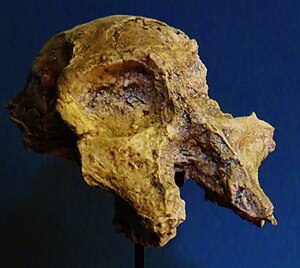Cercopithecoides kimeui
| Cercopithecoides kimeui | ||||||||||||
|---|---|---|---|---|---|---|---|---|---|---|---|---|

View obliquely from above on a female skull of Cercopithecoides kimeui : on both sides below you can see the molars of the upper jaw, on the right front a canine tooth (front teeth and anterior palate area are missing) |
||||||||||||
| Temporal occurrence | ||||||||||||
| Pliocene to Old Pleistocene | ||||||||||||
| 3.18 to 1.65 million years | ||||||||||||
| Locations | ||||||||||||
|
||||||||||||
| Systematics | ||||||||||||
|
||||||||||||
| Scientific name of the genus | ||||||||||||
| Cercopithecoides | ||||||||||||
| Mollet, 1947 | ||||||||||||
| Scientific name of the species | ||||||||||||
| Cercopithecoides kimeui | ||||||||||||
| M. Leakey , 1982 | ||||||||||||
Cercopithecoides kimeui is an extinct species of primate that was foundin East Africa during the Old Pleistocene . According to the first description published in 1982, fossils discoveredin the Olduvai Gorge in Tanzania as well as in Kenya that were found on this species originatefrom sedimentary layers that are around two to three million years old. The species of the genus Cercopithecoides are considered to be relatives of the recent slipper monkeys and colobus monkeys .
Naming
Cercopithecoides is a 1947 with the mainly from South Africa known type species williamsi Cercopithecoides introduced artificial word composed of the generic name of the monkeys ( Cercopithecus ) and the suffix -oides ( Greek for "-similar"). Cercopithecoides therefore refers to morphological similarities between the characteristics of the fossils and the characteristics of species of the vervet monkey living today. Cercopithecus is composed of the Greek πίθηκος (in ancient Greek pronounced píthēkos : "monkey") and κέρκος (kérkos) "tail" and therefore means "tail monkey".
The epithet kimeui honors the Kenyan Kamoya Kimeu , who as assistant to Louis Leakey and Richard Leakey discovered the first fragments of numerous important fossils of the early ancestors of modern humans ( hominini ) in Kenya and Tanzania. Kimeu also led the local helpers in Meave Leakey's team who discovered numerous fossils related to Cercopithecoides kimeui in the Olduvai Gorge .
Initial description
According to the first description published by Meave Leakey in 1982, the holotype of Cercopithecoides kimeui is the partially preserved cranial roof of a male individual with partially dentate left and right upper jaw (archive number 068/6514) from the MLK site in Olduvai, which is 1.65 million years old -Canyon. Around a dozen fossils from the Koobi Fora site (east of Lake Turkana in Kenya), whose age is between 3.18 and 1.89 million years, were also assigned to the species, including several male and female mandibular and maxillary fragments as well Bones from the area below the skull . Cercopithecoides kimeui is very similar to the type species Cercopithecoides williamsi , but is much larger than this, and the molars also give the dentition a different, baboon-like appearance ("papionine appearance often the dentition").
Way of life
Cercopithecoides kimeui is considered to be a relatively large- growing species, the individuals of which were often on the ground. According to the initial description, this is particularly supported by various features of the humerus . The heavy wear and tear on the teeth indicates the consumption of relatively hard grass - possibly mixed with sand - from the open savannah . The lack of fossil finds younger than around 1.6 million years old is attributed to the fact that the climatic changes that occurred during that period - greater drought - could have led to the species becoming extinct.
Cercopithecoides kimeui lived almost at the same time and in the same area as Paracolobus and Rhinocolobus turkanensis .
literature
- Stephen R. Frost et al .: Partial cranium of Cercopithecoides kimeui Leakey, 1982 from Rawi Gully, southwestern Kenya. In: American Journal of Physical Anthropology. Volume 122, No. 3, 2003, pp. 191-199, doi: 10.1002 / ajpa.10279 .
Individual evidence
- ^ Meave Leakey : Extinct Large Colobines From thr Plio-Pleistocene of Africa. In: American Journal of Physical Anthropology. Volume 58, No. 2, 1982, pp. 153-172, doi: 10.1002 / ajpa.1330580207